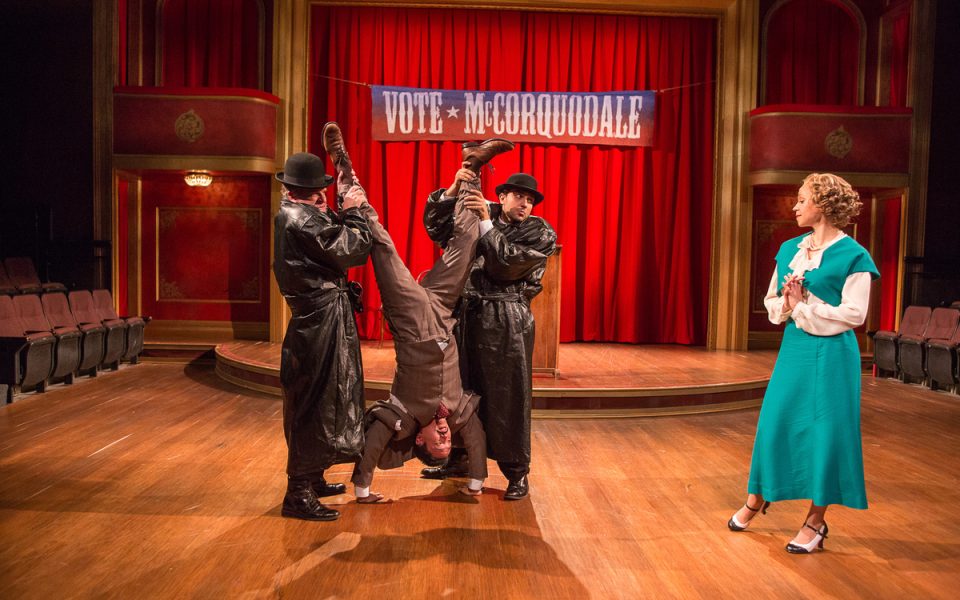by Jordan Green
The 39 Steps, the taut 1935 thriller by Alfred Hitchcock, cemented the director’s future. It’s ranked the fourth best British film of the 20th Century by the British Film Institute, and attracted notice in the United States, paving the way for Hitchcock’s arrival in Hollywood four years later.
As a cultural artifact of interwar Britain, The 39 Steps reflects a justifiable paranoia about German espionage and aspirations for global domination. Even though the film features a classic Hitchcock protagonist who is unjustly hounded by the authorities, it’s a little more innocent and uncomplicated than the film noir tradition that would take shape during World War II.
Playwright Patrick Barlow’s theatrical adaptation of The 39 Steps — first for a limited 1995 production, then for the West End in London in 2005, soon followed on Broadway — pared the cast down to four actors playing all the characters, including, in some instances, male actors portraying female characters. The result is non-stop hilarity, with actors changing character before the audience’s eyes.
Stunning cinematography and witty dialogue in the original film allow viewers to suspend disbelief about a story of the protagonist’s journey to Scotland to clear himself of murder charges by exposing an international espionage ring. And while the play maintains fidelity to the narrative established in the film, the quick role changes and limited stage props deconstruct the storyline, revealing exactly how improbable the whole thing is. Fans of Hitchcock know that his films are embedded with layers of meaning, rewarding close watching. And fittingly the theatrical adaptation is loaded with references to other Hitchcock movies, including a riveting sequence that foreshadows the director’s 1959 spy thriller North by Northwest — an American movie with strong thematic resemblance to The 39 Steps.
All of these elements in the play set up a funhouse of madcap slapstick for the theatergoer who comes along for light entertainment, and enjoyment of a more bracing intellectual variety for the discerning audience member.
The cast in the Triad Stage production of The 39 Steps, under the direction of Jen Wineman, pulled off the gambit with tight precision and rollicking interpersonal chemistry during the Sept. 5 premiere in Greensboro, which also inaugurated the theater’s 2014-15 season.
Brian Lee Huynh, making his Triad Stage debut along with the other two male actors in the production, cuts a dashing figure as protagonist Richard Hannay, using just the right amount of delay in the delivery of his lines to skewer the pretension of the original role. Laura Woodward, portraying all three female characters, particularly shines as the tragic international agent Annabella Schmidt, where her exaggerated facial expressions of alarm and personal dramatics pay comic tribute to early silent films.
Andy Paterson and Sal Cacciato provide nonstop comic locomotion, portraying sets of characters — clowns, Mr. Memory and his emcee, train passengers, goons, a Scots farmer and his wife, a Scots innkeeper and his wife, on it goes. Paterson is particular entertaining as the droll Mr. Memory, a music-hall showman with a freakish ability to recall trivia — and reportedly one of Hitchcock’s favorite characters. Cacciato’s voicing is impeccable as Professor Jordan, embedding a treacherous Third Reich accent within a whinnying, high English affectation. The immediate impression given by his performance is Dr. Evil, the character played by Mike Myers in the Austin Powers film series. That’s fitting because Dr. Evil is a parody of the classic James Bond villains, who in turn owe a debt to Professor Jordan as portrayed by Godfrey Tearle in the 1935 film. More playful deconstruction of the conventions of 20th Century cinema.
The transformation from cinematic drama to theatrical comedy is particularly enlivening in the Forth Bridge scene, with the actors crawling over trunks to depict a chase on an immense span of steel girders. Naturally, it’s hilarious rather than enervating. Likewise, when the characters use freestanding windows and doors to dramatize Hannay’s visit to the Scots farmstead to bring to life a personal triangle of conspiracy and suspicion.
For much of the second part of the story, Hannay and Pamela, one of his female counterparts, are handcuffed together and pretend to be married as they go on the lam after escaping a police car. As a dramatic plot device in the 1935 film, the handcuffs contribute an opportunity for cool humor in the face of awkward circumstances, with Robert Donat and Madeleine Carroll providing a template for future onscreen chemistry between Humphrey Bogart and Lauren Bacall. In reality, the notion is pretty ridiculous, as demonstrated for maximum hilarity, when Woodward attempts to remove her stockings and Huynh’s hand flops marionette-like on her thigh.
There’s certainly an element of silliness in the Triad Stage production — or, for that matter, any of the previous theatrical adaptations — of The 39 Steps. But the resourcefulness and adroit maneuvering required of the actors as a result of the play’s minimal stagecraft ultimately translates into audacity.
Join the First Amendment Society, a membership that goes directly to funding TCB‘s newsroom.
We believe that reporting can save the world.
The TCB First Amendment Society recognizes the vital role of a free, unfettered press with a bundling of local experiences designed to build community, and unique engagements with our newsroom that will help you understand, and shape, local journalism’s critical role in uplifting the people in our cities.
All revenue goes directly into the newsroom as reporters’ salaries and freelance commissions.


Leave a Reply